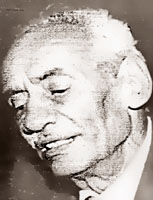
Faces & TracesIbrahim Al-Hadhrani, a magnificent contemporary figure of originality [Archives:2008/1130/Culture]
February 18 2008
 |
Faces & Traces is a cultural series of concise biographies of local or international famous and obscure personalities in fields such as literature, arts, culture and religion in which these individuals contribute affirmatively. It is a short journey in contemporary history, attempting to tackle numerous effective characters in human civilization.
Yemeni poet, revolutionist, politician and diplomat Ibrahim Ahmed Al-Hadhrani was born in 1918 in Dhamar governorate's Kharbat Abu Yabis village. Never attending regular school during his childhood, he learned his primary studies from his father, who was a well-known poet.
When he was 9, Al-Hadhrani and his father moved to Al-Beidha city where the young lad lived as a hostage with Sheikh Al-Rassas until his father paid the money he owed him. During his nearly two years in Al-Beidha, the young Al-Hadhrani was treated aggressively and forced to work hard and exhaustively.
Returning to Aden in 1929 from his journey to India and the Far East, Al-Hadhrani's father dispatched the money he owed Sheikh Al-Rassas and recalled his son to Aden, after which they moved to Taiz where Al-Hadhrani enrolled in school.
During his adolescence in the mid-1930s, Al-Hadhrani lived in Dhamar and attended Al-Shamsiah School where he studied religious and Arabic language sciences, after which he again moved to Taiz.
While in Taiz in the early 1940s and due to the dire economic, social and political situations Yemen suffered under imamate reign, Al-Hadhrani joined the Freemen who were opposed to the imamate, continuing to correspond with those Freemen who escaped to Aden, including Mohammed Mahmud Al-Zubairi and Ahmed Noman.
Following the outbreak of the 1948 Revolution, which ended with the assassination of Imam Yahya and three of his 16 sons, Crown Prince Imam Ahmed fled to Hajjah and soon thereafter regained power in Sana'a.
Immediately following this succession, Freeman Noman was arrested in Dhamar while returning to Sana'a from Aden. Al-Hadhrani was asked to go to Dhamar to try to tempt the city's notables with money to release Noman.
Unfortunately, Al-Hadhrani was arrested in Yarim, joining the other detainees in Dhamar. All then were imprisoned in Hajjah governorate's Naafe'a Prison before being moved to Hajjah's horrible Al-Qahira Prison. Many Freemen were executed while in prison, but Al-Hadhrani escaped death and was only imprisoned for three years.
After being released in the early 1950s, Al-Hadhrani worked at the Foreign Affairs Office in Sana'a during Yemen's Mutawakkil Kingdom. He held this diplomatic position from 1953 until the outbreak of the 1962 Revolution, after which he was appointed a deputy for the Information Ministry and responsible for Yemen's national radio station.
Al-Hadhrani later was nominated for diplomatic posts including becoming a member of Yemen's permanent delegation in the Arab League and being a cultural counselor for the Yemeni embassies in Cairo, Kuwait and Baghdad, starting from the late 1960s until well after the mid-1970s.
Considered a significant icon in the history of Yemeni poetry during the pre-Islamic and Islamic periods; during the country's imamate and post-imamate periods and the beginning of the 21st century, Al-Hadhrani began writing free verse in the early 1940s – 10 years before any other Arab poet would venture into that field.
Publishing his first poem in Al-Hikmah Al-Yamaniah newspaper in 1939, other newspapers of that time, including Al-Bareed Al-Adabi, Sawt Al-Yaman and Fatat Al-Jazeera in Aden, continued publishing his poetic works.
During a short stint in Kuwait, Al-Hadhrani published some of his poems in Al-Bayaan and Al-Kuwait magazines, as well as proofreading for Kuwait's renowned Al-Arabi magazine in the early 1970s.
Al-Hadhrani penned prefaces to several divans and many famous Yemeni singers sang songs of his lyric poetry. He even composed the poem, “Rimal Atsha” (Thirsty Sands), for famed Arab singer Um Kulthum to sing, but she died before receiving it.
The poet himself is mainly to blame for his excessive carelessness regarding documenting and publishing his poetry, as he was age 73 when he began thinking about collecting and issuing his poetic works in a divan. Other reasons hindering the collection of his poetry were that much of his work remains lost among his friends and students. Some work also was lost during his imprisonment and burned due to fear of the imam's guards.
A considerable portion of Al-Hadhrani's poetry was published in the 1991 divan, “Al-Qutoof Al-Dawani fi Shi'ar Ibrahim Al-Hadhrani” (The Approaching Fruitage in Al-Hadhrani's Poetry), prepared by his friend and fellow poet, Mohammed Al-Shami.
Al-Hadhrani's second poetic divan, “Diwan Al-Hadhrani” (Al-Hadhrani's Divan), was published in 2004 during the commemoration of Sana'a as the Arab Culture Capital. This divan included many poems gathered and published for the first time, in addition to lost poems penned during various periods in the poet's life.
Al-Hadhrani was bestowed his country's 2002 Ministry of Culture Award and he also was granted a love letter “a written expression of love and appreciation” in 2007 from Chile's international movement, Poets of the World (Poetas del Mundo).
Al-Hadhrani died November 24, 2007, at age 89 and is buried in Sana'a. For more than half a century, Al-Hadhrani enriched literary life with his prolific poetic works and his literary and poetic body of work will stand as a considerable addition to Yemeni culture throughout the ages.
——
[archive-e:1130-v:15-y:2008-d:2008-02-18-p:culture]


